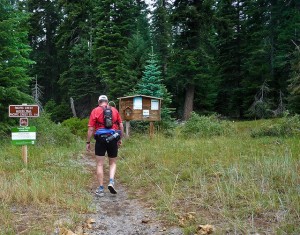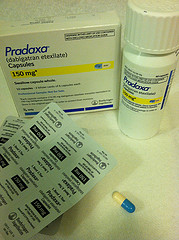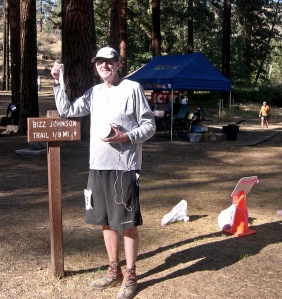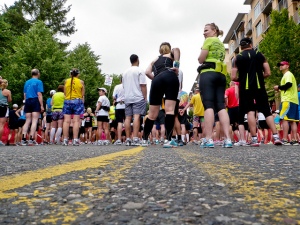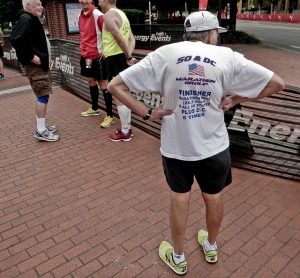
Mountain Biking in Oregon – Waldo Lake Trail
I’ve just returned from a nearly three-hour long mountain bike ride, so I thought it would be a good time to write about mountain biking while in persistent atrial fibrillation (this discussion is pertaining specifically to persistent A fib meaning I am always in atrial fibrillation and don’t ever expect to NOT be in a fib; I think people who have episodes of paroxysmal atrial fibrillation are going to have a different result).
One of my main concerns when I was first verified to have persistent atrial fibrillation was whether or not would be able to continue mountain biking. I started road riding in the early 80s, back when I still lived in the Midwest. When I moved to Klamath Falls, Oregon in 1987 I began mountain biking. This is a great place to ride, and we have a terrific trail system at Moore Park, as well as a couple of local high mountain singletrack trails that are legal for mountain biking (Brown Mountain Trail, Rye Spur Trail). I feel real connection to these trails and have been riding some of them for over twenty-five years.

Rye Spur Trail, Klamath County, Oregon
I didn’t use to run is much as I do now, and back in the late 80s and early 90s I would pretty much mountain bike five or six days per week. I have developed some good bike handling skills, especially since in the early days there was no front or rear suspension, and nobody really knew what they were doing anyway. We pretty much plunged our quick release seat posts down into the frame, switched to granny gear as soon as we hit dirt, and would (inappropriately) lock up our back wheels and skid down steep hills – very much discouraged in this modern era. But that’s the way it was – skills develop over time.

One of my old mountain bikes
At any rate I have developed good skills – skills specific to these particular trails, seeing that I generally know every rock and anticipate every little drop off.
There are two issues with mountain biking and atrial fibrillation. The first, obviously, is that my cardiac output is reduced by about 15 or 20%, so naturally I am a little bit slower. People get slower when they get older, too, so there’s that to deal with as well. But the real issue, I think, is the fact that I am on a potent anticoagulant – Pradaxa. One of the disadvantages of Pradaxa is that it works really well (but the real disadvantages that it does not have a reversal agent). Clearly – there is a risk of bleeding associated with crashing your mountain bike on the trail.
I sort of doubt whether Coumadin is that much safer than Pradaxa as far as this is concerned – while it is true that there is a reversal agent for Coumadin, what is the likelihood that, if I had a major crash, I would be able to get to the emergency department in time for them to give me the reversal agent? I generally ride alone, and our trails are pretty remote. It would take a while for me to get out of there, especially if I was bleeding all over the place, or even worse, if I were bleeding into the space previously occupied by important parts of my brain.
Over the years my skills have improved and my style has changed quite a bit. At age 53 I’m no longer much of a daredevil (I never really was). Back when I was thirty and was riding about five days per week, I estimated that I had one minor crash per week, and usually one major crash per season. In all that time I think I’ve only actually hit my head once (I definitely recall a bleeding ear after crashing on a technical descent on a trail called Garbage – never liked that trail).
I have always felt that all of your instincts and reflexes are directed toward protecting the head. It’s automatic.
Of course I have worn a helmet when bicycling since 1983. I even bought a new helmet when I went into atrial fibrillation and started anticoagulation. It fits better than my old one and it’s florescent green, so hopefully I have less chance of being run over by a pickup truck.
The only time I have ever had a significant bleeding problem while mountain biking was back in 1990. I came off the trail ride and was heading around the paved road at Moore Park to the picnic area to get some water when some young guys in a pickup shouted at me, “Wrong way, dude!” I didn’t yell back at them, but I turned around and glared at them as I zipped down a little hill to the picnic area, giving them a look that said, “You talkin’ to me?” I was going pretty fast at that point and hit a speed bump that sent me skidding across the pavement for a while.
I bet those guys were impressed.
Anyway, I had a lot of road rash, was just goes with bicycling to a certain extent, but the worst thing was I had a “degloving injury” on the side of my abdomen. What that means is that part of my skin more or less stuck to the pavement while the rest of me kept moving and the skin was pulled away from the underlying tissue. It didn’t break all the way through the skin, but I developed a hematoma the size of a baseball right where the “love handle” would normally be. Twenty-three years later it’s actually still there to a certain extent, not the blood, but a big lump of scar tissue beneath the skin, and the skin over that area is still kind of numb.

Klamath Ridgeview Trail – Moore Park
That happened with no anticoagulation – I never even took an aspirin back then. If I had a similar injury now that would’ve been a major hematoma – I might even need a transfusion.
That’s the risk. Falls are part of riding a mountain bike. I’ve been on Pradaxa for a year now and I think I’ve only had two crashes. I am so much more cautious than I used to be that I rarely ever crash, and when I do crash it usually something stupid like having mud or ice in my pedals and not been able to click out when stopping, falling over like Artie Johnson used to do on that tricycle on Rowan and Martin’s Laugh In. I honestly can’t say that I’ve noticed more bruising or bleeding than I would expect prior to Pradaxa. So far, so good.
I feel it is important, however, that when you’re cardiologist tells you that you probably shouldn’t be mountain biking that you do what he says. Don’t be like me. Don’t disregard your cardiologist advice. Do as I say, not as I do.
All joking aside – there is a certain risk and if you can accept that level of risk, then continue mountain biking. If not, stay off the trails.
As far as how much persistent atrial fibrillation affects my climbing, well, when I first get started it is quite difficult. After I warm up it really doesn’t seem like it’s any different than not be in atrial fibrillation. Recall that I do not take anything like a beta blocker or an antiarrhythmic – if you take medications like that your experience may definitely be different. All I take is the anticoagulant.
I’m slow, definitely slower than I was twenty-five years ago, but it almost seems like it’s within the realm of what you’d expect from being that much older. Like I said in the article about running in atrial fibrillation, it’s almost like you’re a pickup truck with a four speed manual transmission, but you can only use second and third gear. But you can still have a lot of fun in those two gears! It just takes a while to warm up.
Personally I think road biking is more dangerous than mountain biking, as far as bleeding risks are concerned. All my best crashes have been on pavement, including my best mountain bike crashes (see above). And pavement is usually where cars, driven by people who are talking or texting on smart-phones, hit you.
As far as endurance and energy output are concerned road biking, by its very nature, is easier to do in persistent atrial fibrillation that mountain biking. On a road bike you get into a groove, and have a certain steady energy output. That’s perfect for atrial fibrillation. Anybody who trail rides, especially on technical, steep trails, can tell you that mountain biking consists of a little burst of energy here, then a little short, brief period of rest and recovery here (by slow pedaling for a couple of seconds), and then hammering the pedals again to get over the next little obstacle, or whatever. That’s what’s fun about it – it’s almost like doing a puzzle. Trail riding involves a lot of little, short, anaerobic bursts of energy – and of course atrial fibrillation has diminished this ability, as far as I’m concerned.
Although, speaking strictly of endurance, I don’t think that is changed too much since I went into persistent atrial fibrillation. I can still ride for just as long as I used to be able to ride. I have found that while I have lost speed with age I have gained endurance in spite of atrial fibrillation.

Moore Park Mountain Bike Trails
I am very interested in other mountain bikers’ experiences with atrial fibrillation, especially athletes who take rate control or anti-arrhythmic medications. Please feel free to leave comments – Thanks!








